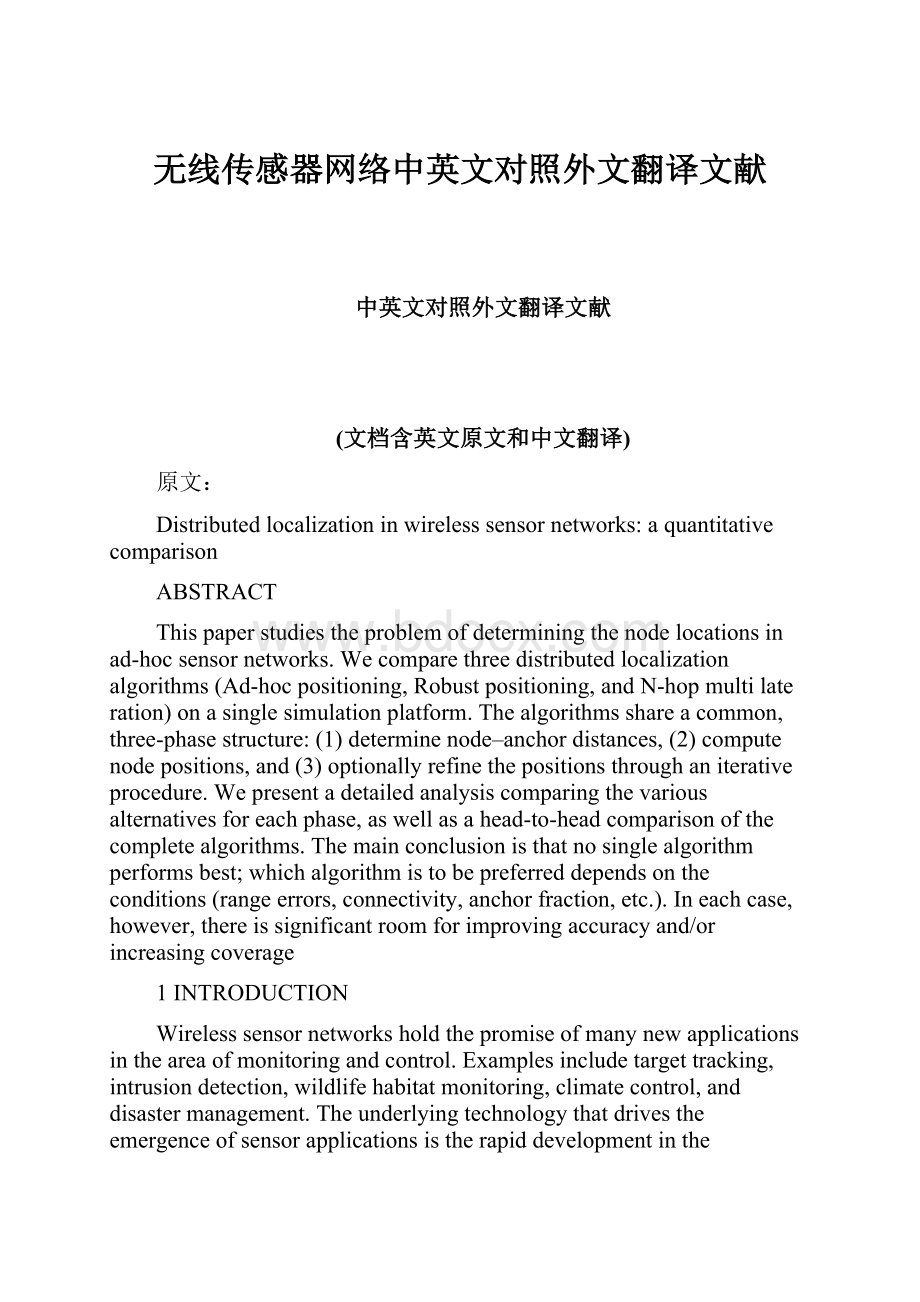无线传感器网络中英文对照外文翻译文献.docx
《无线传感器网络中英文对照外文翻译文献.docx》由会员分享,可在线阅读,更多相关《无线传感器网络中英文对照外文翻译文献.docx(17页珍藏版)》请在冰豆网上搜索。

无线传感器网络中英文对照外文翻译文献
中英文对照外文翻译文献
(文档含英文原文和中文翻译)
原文:
Distributedlocalizationinwirelesssensornetworks:
aquantitativecomparison
ABSTRACT
Thispaperstudiestheproblemofdeterminingthenodelocationsinad-hocsensornetworks.Wecomparethreedistributedlocalizationalgorithms(Ad-hocpositioning,Robustpositioning,andN-hopmultilateration)onasinglesimulationplatform.Thealgorithmsshareacommon,three-phasestructure:
(1)determinenode–anchordistances,
(2)computenodepositions,and(3)optionallyrefinethepositionsthroughaniterativeprocedure.Wepresentadetailedanalysiscomparingthevariousalternativesforeachphase,aswellasahead-to-headcomparisonofthecompletealgorithms.Themainconclusionisthatnosinglealgorithmperformsbest;whichalgorithmistobepreferreddependsontheconditions(rangeerrors,connectivity,anchorfraction,etc.).Ineachcase,however,thereissignificantroomforimprovingaccuracyand/orincreasingcoverage
1INTRODUCTION
Wirelesssensornetworksholdthepromiseofmanynewapplicationsintheareaofmonitoringandcontrol.Examplesincludetargettracking,intrusiondetection,wildlifehabitatmonitoring,climatecontrol,anddisastermanagement.Theunderlyingtechnologythatdrivestheemergenceofsensorapplicationsistherapiddevelopmentintheintegrationofdigitalcircuitry,whichwillbringussmall,cheap,autonomoussensornodesinthenearfuture.
Newtechnologyoffersnewopportunities,butitalsointroducesnewproblems.Thisisparticularlytrueforsensornetworkswherethecapabilitiesofindividualnodesareverylimited.Hence,collaborationbetweennodesisrequired,butenergyconservationisamajorconcern,whichimpliesthatcommunicationshouldbeminimized.Theseconflictingobjectivesrequireunorthodoxsolutionsformanysituations.
ArecentsurveybyAkyildizetal.discussesalonglistofopenresearchissuesthatmustbeaddressedbeforesensornetworkscanbecomewidelydeployed.Theproblemsrangefromthephysicallayer(low-powersensing,processing,andcommunicationhardware)allthewayuptotheapplicationlayer(queryanddatadisseminationprotocols).Inthispaperweaddresstheissueoflocalizationinad-hocsensornetworks.Thatis,wewanttodeterminethelocationofindividualsensornodeswithoutrelyingonexternalinfrastructure(basestations,satellites,etc.).
Thelocalizationproblemhasreceivedconsiderableattentioninthepast,asmanyapplicationsneedtoknowwhereobjectsorpersonsare,andhencevariouslocationserviceshavebeencreated.Undoubtedly,theGlobalPositioningSystem(GPS)isthemostwell-knownlocationserviceinusetoday.TheapproachtakenbyGPS,however,isunsuitableforlow-cost,ad-hocsensornetworkssinceGPSisbasedonextensiveinfrastructure(i.e.,satellites).Likewisesolutionsdevelopedintheareaofroboticandubiquitouscomputingaregenerallynotapplicableforsensornetworksastheyrequiretoomuchprocessingpowerandenergy.
Recentlyanumberoflocalizationsystemshavebeenproposedspecificallyforsensornetworks.Weareinterestedintrulydistributedalgorithmsthatcanbeemployedonlarge-scalead-hocsensornetworks(100+nodes).Suchalgorithmsshouldbe:
•self-organizing(i.e.,donotdependonglobalinfrastructure),
•robust(i.e.,betoleranttonodefailuresandrangeerrors),
•energyefficient(i.e.,requirelittlecomputationand,especially,communication).
Theserequirementsimmediatelyruleoutsomeoftheproposedlocalizationalgorithmsforsensornetworks.Wecarriedoutathoroughsensitivityanalysisonthreealgorithmsthatdomeettheaboverequirementstodeterminehowwelltheyperformundervariousconditions.Inparticular,westudiedtheimpactofthefollowingparameters:
rangeerrors,connectivity(density),andanchorfraction.Thesealgorithmsdifferintheirpositionaccuracy,networkcoverage,inducednetworktraffic,andprocessorload.Giventhe(slightly)differentdesignobjectivesforthethreealgorithms,itisnosurprisethateachalgorithmoutperformstheothersunderaspecificsetofconditions.Undereachcondition,however,eventhebestalgorithmleavesmuchroomforimprovingaccuracyand/orincreasingcoverage.
Themaincontributionsofourworkdescribedinthispaperare:
•weidentifyacommon,three-phase,structureinthedistributedlocalizationalgorithms.
•weidentifyagenericoptimizationapplicabletoallalgorithms.
•weprovideadetailedcomparisononasingle(simulation)platform.
•weshowthatthereisnoalgorithmthatperformsbest,andthatthereexistsroomforimprovementinmostcases.
Section2discussestheselection,genericstructure,andoperationofthreedistributedlocalizationalgorithmsforlarge-scalead-hocsensornetworks.Thesealgorithmsarecomparedonasimulationplatform,whichisdescribedinSection3.Section4presentsintermediateresultsfortheindividualphases,whileSection5providesadetailedoverallcomparisonandanin-depthsensitivityanalysis.Finally,wegiveconclusionsinSection6.
2LOCALIZATIONALGORITHMS
Beforediscussingdistributedlocalizationindetail,wefirstoutlinethecontextinwhichthesealgorithmshavetooperate.Afirstconsiderationisthattherequirementforsensornetworkstobeself-organizingimpliesthatthereisnofinecontrolovertheplacementofthesensornodeswhenthenetworkisinstalled(e.g.,whennodesaredroppedfromanairplane).Consequently,weassumethatnodesarerandomlydistributedacrosstheenvironment.Forsimplicityandeaseofpresentationwelimittheenvironmentto2dimensions,butallalgorithmsarecapableofoperatingin3D.Fig.1showsanexamplenetworkwith25nodes;pairsofnodesthatcancommunicatedirectlyareconnectedbyanedge.Theconnectivityofthenodesinthenetwork(i.e.,theaveragenumberofneighbors)isanimportantparameterthathasastrongimpactontheaccuracyofmostlocalizationalgorithms(seeSections4and5).Itcanbesetinitiallybyselectingaspecificnodedensity,andinsomecasesitcanbesetdynamicallybyadjustingthetransmitpoweroftheRFradioineachnode.
Insomeapplicationscenarios,nodesmaybemobile.Inthispaper,however,wefocusonstaticnetworks,wherenodesdonotmove,sincethisisalreadyachallengingconditionfordistributedlocalization.Weassumethatsomeanchornodeshaveaprioriknowledgeoftheirownpositionwithrespecttosomeglobalcoordinatesystem.Notethatanchornodeshavethesamecapabilities(processing,communication,energyconsumption,etc.)asallothersensornodeswithunknownpositions;wedonotconsiderapproachesbasedonanexternalinfrastructurewithspecializedbeaconnodes(accesspoints)asusedin,forexample,theGPS-lesslocationsystemandtheCricketlocationsystem.Ideallythefractionofanchornodesshouldbeaslowaspossibletominimizetheinstallationcosts,andoursimulationresultsshowthat,fortunately,mostalgorithmsareratherinsensitivetothenumberofanchorsinthenetwork.
Thefinalelementthatdefinesthecontextofdistributedlocalizationisthecapabilitytomeasurethedistancebetweendirectlyconnectednodesinthenetwork.FromacostperspectiveitisattractivetousetheRFradioformeasuringtherangebetweennodes,forexample,byobservingthesignalstrength.Experiencehasshown,however,thatthisapproachyieldspoordistanceestimates.Muchbetterresultsareobtainedbytime-of-flightmeasurements,particularlywhenacousticandRFsignalsarecombined;accuraciesofafewpercentofthetransmissionrangearereported.Oursimulationresultsprovideinsightintotheeffectoftheaccuracyofthedistancemeasurementsonthelocalizationalgorithms.
Itisimportanttorealizethatthemainthreecontextparameters(connectivity,anchorfraction,andrangeerrors)aredependent.Poorrangemeasurementscanbecompensatedforbyusingmanyanchorsand/orahighconnectivity.Thispaperprovidesinsightinthecomplexrelationbetweenconnectivity,anchorfraction,andrangeerrorsforanumberofdistributedlocalizationalgorithms.
2.1GENERICAPPROACH
Fromtheknownlocalizationalgorithmsspecificallyproposedforsensornetworks,weselectedthethreeapproachesthatmeetthebasicrequirementsforself-organization,robustness,andenergy-efficiency:
•Ad-hocpositioningbyNiculescuandNath,
•N-hopmultilaterationbySavvidesetal,and
•RobustpositioningbySavareseetal.
Theotherapproachesoftenincludeacentralprocessingelement,relyonanexternalinfrastructure,orinducetoomuchcommunication.Thethreeselectedalgorithmsarefullydistributedanduselocalbroadcastforcommunicationwithimmediateneighbors.Thislastfeatureallowsthemtobeexecutedbeforeanymultihoproutingisinplace,hence,theycansupportefficientlocation-basedroutingschemeslikeGAF.
Althoughthethreealgorithmsweredevelopedindependently,wefoundthattheyshareacommonstructure.Wewereabletoidentifythefollowinggeneric,three-phaseapproach1for
determiningtheindividualnodepositions:
1.Determinethedistancesbetweenunknownsandanchornodes.
2.Deriveforeachnodeapositionfromitsanchordistances.
3.Refinethenodepositionsusinginformationabouttherange(distance)to,andpositionsofneighboringnodes.
Theoriginaldescriptionsofthealgorithmspresentthefirsttwophasesasasingleentity,butwefoundthatseparatingthemprovidestwoadvantages.First,weobtainabetterunderstandingofthecombinedbehaviorbystudyingintermediateresults.Second,itbecomespossibletomix-and-matchalternativesforbothphasestotailorthelocalizationalgorithmtotheexternalconditions.Therefinementp